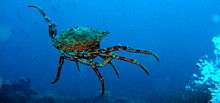Maja squinado
| Maja squinado | |
|---|---|
 | |
| Scientific classification | |
| Kingdom: | Animalia |
| Phylum: | Arthropoda |
| Subphylum: | Crustacea |
| Class: | Malacostraca |
| Order: | Decapoda |
| Infraorder: | Brachyura |
| Family: | Majidae |
| Genus: | Maja [Note 1] |
| Species: | M. squinado |
| Binomial name | |
| Maja squinado (Herbst, 1788) | |
Maja squinado (the European spider crab, spiny spider crab or spinous spider crab) is a species of migratory crab found in the north-east Atlantic and the Mediterranean Sea.[1]
Diet
M. squinado feeds on a great variety of organisms, with seaweeds and molluscs dominating in winter, and echinoderms such as sea urchins and sea cucumbers in summer.[2]
Behaviour
Migrations generally take place in autumn,[3] with some crabs covering over 100 miles (160 km) in eight months.[4] All crabs are vulnerable to predation when moulting, and M. squinado becomes gregarious around that time, presumably for defense against predators.[5] Females can produce up to four broods per year.[6]
Fishery
M. squinado is the subject of commercial fishery, with over 5,000 tonnes caught annually, more than 70% of it off the coast of France, over 10% off the coast of the United Kingdom, 6% from the Channel Islands, 3% from each of Spain and Ireland, 2% from Croatia, 1% from Portugal, and the remainder coming from Montenegro, Denmark and Morocco,[7] although official production figures are open to doubt.[1] The European Union imposes a minimum landing size of 120 mm for M. squinado,[8] and some individual countries have other regulations, such as a ban on landing egg-bearing females in Spain and a closed season in France and the Channel Islands.[1]
Taxonomy

A review of the species complex around M. squinado was able to differentiate between specimens from the Mediterranean Sea and those from the Atlantic, and concluded that the Atlantic specimens were a separate species, called Maja brachydactyla Balss, 1922.[9] The specific epithet squinado derives from the Provençal name for the species – squinado, esquinade, esquinado or esquinadoun — recorded by Rondelet as early as 1554.[4]
Notes
- ↑ The genus Maja is sometimes spelled Maia.
References
| External identifiers for Maja squinado | |
|---|---|
| Encyclopedia of Life | 1021796 |
| ITIS | 199961 |
| NCBI | 99391 |
| WoRMS | 107350 |
| Wikimedia Commons has media related to Maja squinado. |
- 1 2 3 Carl Meyer. "Maja squinado, the European Spider Crab: Biology and Fishery". University of Hawaii. Retrieved October 4, 2010.
- ↑ Bernardez, C., J. Freire & E. Gonzalez–Gurriaran, (2000). "Feeding of the spider crab Maja squinado in rocky subtidal areas of the Ria de Arousa (north-west Spain)". Journal of the Marine Biological Association of the United Kingdom. 80 (1): 95–102. doi:10.1017/S0025315499001605.
- ↑ E. Gonzalez–Gurriaran, J. Freire & C. Bernardez (2002). "Migratory patterns of female spider crabs Maja squinado detected using electronic tags and telemetry". Journal of Crustacean Biology. 22 (1): 91–97. doi:10.1651/0278-0372(2002)022[0091:MPOFSC]2.0.CO;2.
- 1 2 Le Foll, D. (November 1, 1993). "Biology and fisheries of the spider crab Maja squinado (Herbst) in western English Channel" (PDF) (in French). Ph.D. thesis, Université de Bretagne Occidentale.
- ↑ Sampedro, M. P. & E. Gonzalez–Gurriaran (2004). "Aggregating behaviour of the spider crab Maja squinado in shallow waters". Journal of Crustacean Biology. 24 (1): 168–177. doi:10.1651/C-2404.
- ↑ L. Garcia–Florez & P. Fernandez–Rueda (2000). "Reproductive biology of spider crab females (Maja brachydactyla) off the coast of Asturias (north-west Spain)". Journal of the Marine Biological Association of the United Kingdom. 80 (6): 1071–1076. doi:10.1017/S0025315400003131.
- ↑ "Global Capture Production 1950–2004". Food and Agriculture Organization. September 9, 2006.
- ↑ "Council Regulation (EEC) No 3094/86". Official Journal of the European Economic Community. October 7, 1986.
- ↑ Neumann, V. (1998). "A review of the Maja squinado (Crustacea : Decapoda : Brachyura) species-complex with a key to the eastern Atlantic and Mediterranean species of the genus". Journal of Natural History. 32 (10–11): 1667–1684. doi:10.1080/00222939800771191.